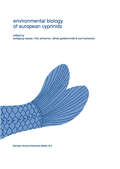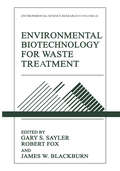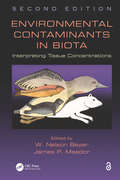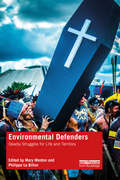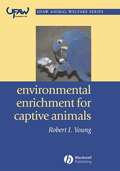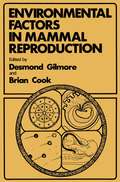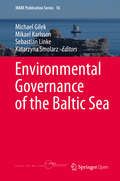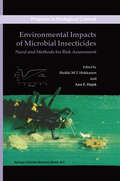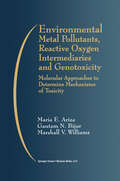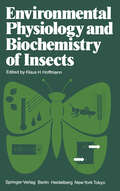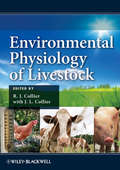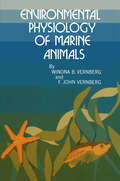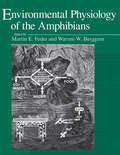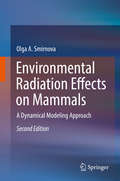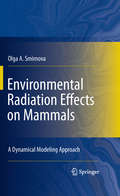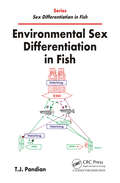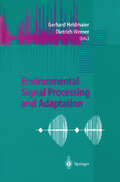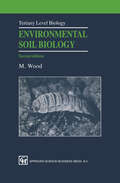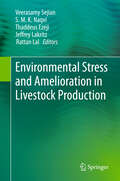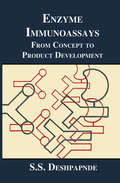- Table View
- List View
Environmental biology of European cyprinids: Papers from the workshop on ‘The Environmental Biology of Cyprinids’ held at the University of Salzburg, Austria, in September 1989 (Developments in Environmental Biology of Fishes #13)
by W. Wieser F. Schiemer A. Goldschmidt K. KotrschalEnvironmental Biotechnology for Waste Treatment (Environmental Science Research #41)
by Gary S. Sayler Robert Fox James BlackburnThe use of biotechnical processes in control of environmental pollution and in haz ardous waste treatment is viewed as an advantageous alternative or adduct to phys ical chemical treatment technologies. Yet, the development and implementation of both conventional and advanced biotechnologies in predictable and efficacious field applications suffer from numerous technical, regulatory, and societal uncertainties. With the application of modern molecular biology and genetic engineering, there is clear potential for biotechnical developments that will lead to breakthroughs in controlled and optimized hazardous waste treatment for in situ and unit process use. There is, however, great concern that the development of these technologies may be needlessly hindered in their applications and that the fundamental research base may not be able to sustain continued technology development. Some of these issues have been discussed in a fragmented fashion within the research and development community. A basic research agenda has been established to promote a sustainable cross-disciplinary technology base. This agenda includes developing new and improved strains for biodegradation, improving bioanalytical methods to measure strain and biodegradation performance, and providing an in tegrated environmental and reactor systems analysis approach for process control and optimization.
Environmental Contaminants in Biota: Interpreting Tissue Concentrations, Second Edition
by W. Nelson BeyDiscussing the interpretation of tissue concentrations of contaminants in wildlife, this updated edition of a bestseller draws on current scientific research and includes new chapters and greater emphasis on aquatic organisms. Each chapter provides a summary and review of a specific chemical along with direction on research methods and the interpretation of conflicting or insufficient data. Chapters include a comprehensive history of contaminant interpretation in wildlife and fish, the use of tissue residues in ecological risk assessment, and detailed coverage of all bioaccumulative contaminants and their physiologic affects.
Environmental Contaminants in Biota: Interpreting Tissue Concentrations, Second Edition
by W. Nelson Beyer James P. MeadorExamining tissue residues of contaminants in biota reveals the movement of contaminants within organisms and through food chains as well as the context for understanding and quantifying injuries to organisms and their communities. Yet tissue concentrations of some contaminants are especially challenging to interpret and the ability of today's analy
Environmental Defenders: Deadly Struggles for Life and Territory (Routledge Explorations in Environmental Studies)
by Mary Menton; Philippe Le BillonThis book is about environmental defenders and the violence they face while seeking to protect their land and the environment. Between 2002 and 2019, at least two thousand people were killed in 57 countries for defending their lands and the environment. Recent policy initiatives and media coverage have provided much needed attention to the protection and support of defenders, but there has so far been little scholarly work. This edited volume explains who these defenders are, what threats they face, and what can be done to help support and protect them. Delving deep into the complex relations between and within communities, corporations, and government authorities, the book highlights the diversity of defenders, the collective character of their struggles, the many drivers and forms of violence they are facing, as well as the importance of emotions and gendered dimensions in protests and repression. Drawing on global case studies, it examines the violence taking place around different types of development projects, including fossil fuels, agro-industrial, renewable energy, and infrastructure. The volume also examines the violence surrounding conservation projects, including through militarized wildlife protection and surveillance technologies. The book concludes with a reflection on the perspectives of defenders about the best ways to support and protect them. It contrasts these with the lagging efforts of an international community often promoting economic growth over the lives of defenders. This volume is essential reading for all interested in understanding the challenges faced by environmental defenders and how to help and support them. It will also appeal to students, scholars and practitioners involved in environmental protection, environmental activism, human rights, social movements and development studies.
Environmental Defenders: Deadly Struggles for Life and Territory (Routledge Explorations in Environmental Studies)
by Mary Menton Philippe Le BillonThis book is about environmental defenders and the violence they face while seeking to protect their land and the environment. Between 2002 and 2019, at least two thousand people were killed in 57 countries for defending their lands and the environment. Recent policy initiatives and media coverage have provided much needed attention to the protection and support of defenders, but there has so far been little scholarly work. This edited volume explains who these defenders are, what threats they face, and what can be done to help support and protect them. Delving deep into the complex relations between and within communities, corporations, and government authorities, the book highlights the diversity of defenders, the collective character of their struggles, the many drivers and forms of violence they are facing, as well as the importance of emotions and gendered dimensions in protests and repression. Drawing on global case studies, it examines the violence taking place around different types of development projects, including fossil fuels, agro-industrial, renewable energy, and infrastructure. The volume also examines the violence surrounding conservation projects, including through militarized wildlife protection and surveillance technologies. The book concludes with a reflection on the perspectives of defenders about the best ways to support and protect them. It contrasts these with the lagging efforts of an international community often promoting economic growth over the lives of defenders. This volume is essential reading for all interested in understanding the challenges faced by environmental defenders and how to help and support them. It will also appeal to students, scholars and practitioners involved in environmental protection, environmental activism, human rights, social movements and development studies.
Environmental Enrichment for Captive Animals (UFAW Animal Welfare #1)
by Robert J. YoungEnvironmental enrichment is a simple and effective means of improving animal welfare in any species – companion, farm, laboratory and zoo. For many years, it has been a popular area of research, and has attracted the attention and concerns of animal keepers and carers, animal industry professionals, academics, students and pet owners all over the world. This book is the first to integrate scientific knowledge and principles to show how environmental enrichment can be used on different types of animal. Filling a major gap, it considers the history of animal keeping, legal issues and ethics, right through to a detailed exploration of whether environmental enrichment actually works, the methods involved, and how to design and manage programmes. The first book in a major new animal welfare series Draws together a large amount of research on different animals Provides detailed examples and case studies An invaluable reference tool for all those who work with or study animals in captivity This book is part of the UFAW/Wiley-Blackwell Animal Welfare Book Series. This major series of books produced in collaboration between UFAW (The Universities Federation for Animal Welfare), and Wiley-Blackwell provides an authoritative source of information on worldwide developments, current thinking and best practice in the field of animal welfare science and technology. For details of all of the titles in the series see www.wiley.com/go/ufaw.
Environmental Enrichment for Captive Animals
by Robert J. YoungEnvironmental enrichment is a simple and effective means of improving animal welfare in any species – companion, farm, laboratory and zoo. For many years, it has been a popular area of research, and has attracted the attention and concerns of animal keepers and carers, animal industry professionals, academics, students and pet owners all over the world. This book is the first to integrate scientific knowledge and principles to show how environmental enrichment can be used on different types of animal. Filling a major gap, it considers the history of animal keeping, legal issues and ethics, right through to a detailed exploration of whether environmental enrichment actually works, the methods involved, and how to design and manage programmes. The first book in a major new animal welfare series Draws together a large amount of research on different animals Provides detailed examples and case studies An invaluable reference tool for all those who work with or study animals in captivity This book is part of the UFAW/Wiley-Blackwell Animal Welfare Book Series. This major series of books produced in collaboration between UFAW (The Universities Federation for Animal Welfare), and Wiley-Blackwell provides an authoritative source of information on worldwide developments, current thinking and best practice in the field of animal welfare science and technology. For details of all of the titles in the series see www.wiley.com/go/ufaw.
Environmental Factors in Mammal Reproduction: (pdf) (Studies in Biology, Economy and Society)
by Desmond Gilmore Brian CookEnvironmental Governance of the Baltic Sea (MARE Publication Series #10)
by Michael Gilek Mikael Karlsson Sebastian Linke Katarzyna SmolarzThis edited volume presents a comprehensive and coherent interdisciplinary analysis of challenges and possibilities for sustainable governance of the Baltic Sea ecosystem by combining knowledge and approaches from natural and social sciences. Focusing on the Ecosystem Approach to Management (EAM) and associated multi-level, multi-sector and multi-actor challenges, the book provides up-to-date descriptions and analyses of environmental governance structures and processes at the macro-regional Baltic Sea level. Organised in two parts, Part 1 presents in-depth case studies of environmental governance practices and challenges linked to five key environmental problems - eutrophication, chemical pollution, overfishing, oil discharges and invasive species. Part 2 analyses and compares governance challenges and opportunities across the five case studies, focusing on governance structures and EAM implementation, knowledge integration and science support, as well as stakeholder communication and participation. Based on these cross-case comparisons, this book also draws a set of general conclusions on possible ways of improving the governance of the Baltic Sea by promoting what are identified as vital functions of environmental governance: coordination, integration, interdisciplinarity, precaution, deliberation, communication and adaptability.
Environmental Impacts of Microbial Insecticides: Need and Methods for Risk Assessment (Progress in Biological Control #1)
by Heikki M. T. Hokkanen Ann HajekBiological pesticides are increasingly finding therr place in IPM and increasing numbers of products are making therr way to the marketplace. Particularly in China, Latin America and Australia, implementation is proceeding on a large scale. However, in the USA and Europe, registration procedures for insect pathogens to be used for insect control have been established that requrre low levels of risk, resulting in costs of retarding the implementation of microbial agents. This book provides a review of the state of the art of studies on the envrronmental impact of microbial insecticides. It originates from a Society for Invertebrate Pathology Microbial Control Division Symposium .. Assessment of envrronmental safety of biological insecticides", organised in collaboration with the EU-ERBIC research project (FAIR5-CT97-3489). This symposium was initiated by Heikki Hokkanen and Chris Lomer, and was held at the SIP Annual Meeting in 2001 in The Netherlands. The emphasis in this book is on large scale use of microbial agents for insect control, demonstrating how this use has been proceeding with minimal envrron mental impact. This book is intended to be of use to regulatory authorities in determining whether further studies in eertain areas are necessary and how to conduct them if needed, or whether sufficient information has been collected already to permit fuH registration of many of these biological control agents.
Environmental Metal Pollutants, Reactive Oxygen Intermediaries and Genotoxicity: Molecular Approaches to Determine Mechanisms of Toxicity
by Maria E. Ariza Gautam N. Bijur Marshall V. WilliamsHumans are exposed daily to low concentrations of metals that are released into the environment by both natural and industrial processes. Environmental Metal Pollutants, Reactive Oxygen Intermediaries and Genotoxicity: Molecular Approaches to Determine Mechanisms of Toxicity examines concerns about the acute and/or chronic exposure of humans to concentrations of these metals that are below the threshold levels established by various federal regulatory agencies. Some of these metals are accumulated in various tissues and over time this may result in the accumulation of a significant body burden. This could increase the risk of developing a variety of diseases later in life, at a time when thresholds for such effects may already be reduced by the processes of aging. Such possibilities could only further compromise the quality of life in the elderly population and could contribute to the rising cost of health care in this country. Studies that have been conducted to determine the possible risks associated with exposure to relatively non-toxic concentrations of environmental metals have been hampered by a lack of appropriate models and a lack of funding. It has also been difficult for researchers to demonstrate a correlation between the exposure of humans or animals to low concentrations of environmental pollutants and disease. This book examines recent technological advances in the areas of molecular biology, biochemistry, and computer-enhanced image analyses that provide researchers with the tools to begin elucidating the genotoxic effects of environmental metal pollutants and the mechanisms by which these metals cause DNA damage. Environmental Metal Pollutants, Reactive Oxygen Intermediaries and Genotoxicity: Molecular Approaches to Determine Mechanisms of Toxicity presents data that demonstrate that certain environmental metal pollutants are genotoxic. The authors describe the role of reactive oxygen intermediates in causing the DNA damage induced by environmental metal pollutants and discuss their possible role in human disease.
Environmental Physiology and Biochemistry of Insects
by K. H HoffmannOf all the zoological classes the insects are the most numerous in species and the most varied in structure. Estimates of the number 18 of species vary from 1 to 10 million, and 10 individuals are es timated to be alive at any given moment. In their evolution, in sects are relatively ancient and, therefore, they have proved to be a phenomenally successful biological design which has survived unchanged in its basic winged form during the last 300 m. y. In sects were the first small animals to colonize the land with full suc cess. Their small size opened many more ecological niches to them and permitted a greater diversification than the vertebrates. What is it about this design that has made insects so successful in habitats stretching from arid deserts to the Arctic and Antarctic and from freshwater brooks to hot springs and salines? Is it due to the adapta bility of their behavior, physiology, and biochemistry to changing environmental conditions? Three features of insects are of particular importance in determin ing their physiological relationship with the environment: their small size, as mentioned above, the impermeability and rigidity of their exoskeleton, and their poikilothermy. Of course, as with any other animals, the insects' success in its environment depends on its ability to maintain its internal state within certain tolerable limits of temperature, osmotic pressure, pH or oxygen concentra tion (homoeostasis).
Environmental Physiology of Livestock
by R. J. CollierEnvironmental stress is one of the most significant factors affecting livestock performance and health, and it is only expected to increase with effects of global warming. Environmental Physiology of Livestock brings together the latest research on environmental physiology, summarizing progress in the field and providing directions for future research. Recent developments in estimating heat stress loads are discussed, as well as key studies in metabolism, reproduction, and genetic expressions. Environmental Physiology of Livestock begins with a survey of current heat indexing tools, highlighting recent discoveries in animal physiology, changes in productivity levels, and new technologies available to better estimate stress response. Using this synopsis as a point of orientation, later chapters hone in on major effects of heat stress, including changing metabolic pathways and nutrient requirements, endocrine regulation of acclimation to environmental stress, and reduced reproductive performance. The text concludes with a thorough discussion of environmental effects on gene expressions, providing important insight for future breeding practices. Environmental Physiology of Livestock is a globally contributed volume and a key resource for animal science researchers, geneticists, and breeders.
Environmental Physiology of Livestock
by R. J. Collier J. L. CollierEnvironmental stress is one of the most significant factors affecting livestock performance and health, and it is only expected to increase with effects of global warming. Environmental Physiology of Livestock brings together the latest research on environmental physiology, summarizing progress in the field and providing directions for future research. Recent developments in estimating heat stress loads are discussed, as well as key studies in metabolism, reproduction, and genetic expressions. Environmental Physiology of Livestock begins with a survey of current heat indexing tools, highlighting recent discoveries in animal physiology, changes in productivity levels, and new technologies available to better estimate stress response. Using this synopsis as a point of orientation, later chapters hone in on major effects of heat stress, including changing metabolic pathways and nutrient requirements, endocrine regulation of acclimation to environmental stress, and reduced reproductive performance. The text concludes with a thorough discussion of environmental effects on gene expressions, providing important insight for future breeding practices. Environmental Physiology of Livestock is a globally contributed volume and a key resource for animal science researchers, geneticists, and breeders.
Environmental Physiology of Marine Animals
by W. B. Vernberg F. J. VernbergWithin recent years man has become increasingly aware of the disastrous environmental changes that he has introduced, and therefore society is now more concerned about understanding the adaptations organisms have evolved in order to survive and flourish in their environment. Because much of the information pertaining to this subject is scattered in various journals or special symposia proceedings, our purpose in writing this book is to bring together in a college-and graduate-student text the principal concepts of the environmental physiology of the animals that inhabit one of the major realms of the earth, the sea. Our book is not meant to be a definitive treatise on the physiological adap tation of the animals that inhabit the marine environment. Instead, we have tried to highlight some of the physiological mechanisms through which these animals have been able to meet the challenges of their environment. We have not written this book for anyone particular scientific discipline; rather, we hope that it will have an interdisciplinary appeal. It is meant to be both a reference text and a text for teaching senior undergraduate and graduate courses in marine biology, physiological ecology of marine animals, and envi ronmental physiology of marine animals.
Environmental Physiology of the Amphibians
by Martin E. Feder Warren W. BurggrenThrough its emphasis on recent research, its many summary tables, and its bibliography of more than 4,000 entries, this first modern, synthetic treatment of comparative amphibian environmental physiology emerges as the definitive reference for the field. Forty internationally respected experts review the primary data, examine current research trends, and identify productive avenues for future research.
Environmental Radiation Effects on Mammals: A Dynamical Modeling Approach
by Olga A. SmirnovaDr. Smirnova's updated text is devoted to the theoretical studies of radiation effects on mammals. It summarizes 35 years of results the author obtained from analyzing dose rate equivalents for the Galactic Cosmic Rays (GCR) and for Solar Particles Events (SPE). This edition also includes two new chapters on skin epidermal epithelium and risk assessment for myeloid leukemia, as well as extended revisions addressing the radiation effects on the blood-forming system. Mathematical models are used to explain the effects of both acute and chronic irradiation on the dynamics of vital body systems, like the hematopoietic system, the development of autoimmune diseases, and the mortality dynamics in homogeneous and nonhomogeneous mammalian populations. The proposed methodology of these studies, the models themselves, and the obtained results are of a great theoretical significance and can find wide practical use.
Environmental Radiation Effects on Mammals: A Dynamical Modeling Approach
by Olga A. SmirnovaThemonographisdevotedtothetheoreticalstudiesofradiationeffectsonmammals. It summarizes the results obtained by the author over the past 30 years, most of them being of high priority. In the course of these studies, a single approach to the modeling of radiation effects on mammals has been elaborated. Speci?cally, in the framework of the developed deterministic mathematical models, the effects of both acute and chronic irradiation in a wide range of doses and dose rates on vital body systems (hematopoiesis, small intestine, and humoral immunity), as well as on the development of autoimmune diseases, are investigated. The radiation effects on the mortality dynamics in homogeneous and nonhomogeneous(in radiosensitivity) mammalian populations are also studied by making use of the developed stochastic models. The most appealing feature of these mortality models consists of the fact that they account for the intrinsic properties of the exposed organism. Namely, within these models the stochastic biometrical functions are calculated proceeding from statistical characteristics and dynamics of the respective critical body system (hematopoiesis or small intestine). The performed theoretical investigations contribute to the development of the system and quantitative approaches in radiation biology and ecology. These studies elucidate the major regulatory mechanisms of the damage and recovery processes running in the vital body systems of exposed mammals and reveal the key par- eters characterizing the processes.
Environmental Sex Differentiation in Fish
by T. J. PandianFish constitute an important natural renewable resource and any reduction in their ability to propagate as a result of human interference may have significant socioeconomic consequences. The negative effect of human activity on sex differentiation and reproductive output in fish is so diverse that it has been difficult to encompass it in a single b
Environmental Signal Processing and Adaptation
by DietrichWerner GerhardHeldmaierAnimals and plants live in changing environmental conditions which require adaptation in order to cope with this. Some of these environmental changes serve as signals which have to be "sensed" and interpreted correctly by the organisms to initiate the adaptation. This signal processing is based on biochemical, molecular and neuronal processes which are discussed in this book. All examples given underline that continuous adjustment of physiological functions is an essential requirement for life and survival in complex changing environments.
Environmental Soil Biology (Experimental and Clinical Neuroscience)
by M. WoodEnvironmental considerations are playing an increasingly important role in determining management strategies for soil and land. Many important environmental issues involve aspects of the biology of soil, and these issues cannot be considered satisfactorily in isolation from a general understanding of soil biology as a whole. This is the second edition of a book first published in 1989 and now thoroughly rewritten to focus on soil ecology and environmental issues. The first part of the book provides an introduction to soils, its inhabitants, and their activities. The second part covers the influence of man on the natural cycles of soil. Topics such as acid rain and nitrogen fertilizers are considered alongside pesticides and genetically modified organisms. A new final chapter has been added which considers how, as we move towards the next millennium, we can apply the concept of sustainability to issues such as global climate change and farming systems. The book is directed at advanced undergraduate and immediate postgraduate students in environmental science and soil ecology, with students of physical geography and earth sciences as an important secondary market.
Environmental Stress and Amelioration in Livestock Production
by Veerasamy Sejian, S.M.K. Naqvi, Thaddeus Ezeji, Jeffrey Lakritz and Rattan LalGiven the importance of livestock to the global economy, there is a substantial need for world-class reference material on the sustainable management of livestock in diverse eco-regions. With uncertain climates involving unpredictable extreme events (e.g., heat, drought, infectious disease), environmental stresses are becoming the most crucial factors affecting livestock productivity. By systematically and comprehensively addressing all aspects of environmental stresses and livestock productivity, this volume is a useful tool for understanding the various intricacies of stress physiology. With information and case studies collected and analyzed by professionals working in diversified ecological zones, this book explores the influence of the environment on livestock production across global biomes. The challenges the livestock industry faces in maintaining the delicate balance between animal welfare and production are also highlighted.
Enzyme Induction (Basic Life Sciences #6)
by Dennis ParkeOur present concepts ofthe regulation of enzyme activity in the cell have been largely based on the extensive body of work which has been carried out with micro-organisms. A distinction between constitutive and adaptive enzymes had already been made well before World War II and work on enzyme adaptation, both in yeast and bacteria, was done by several workers, especially Marjorie Stephenson and her group in Cambridge in the 1930s. In studies starting about 1947 Stanier demonstrated that the oxidation of aromatic compounds by species of Pseudomonas involved the coordinate and sequential induction of a group of enzymes concerned in the orderly catabolism of a substrate which acted as the inducer. The investigations of Umbarger and of Pardee, both in 1956, established the principle, which is now firmly established for almost all anabolic reaction chains, that the first 'committed' step in a biosynthetic pathway is sensitive to feedback control by the final product of the particular reaction sequence. This control can be exercised in two ways. It can either act on the rate of formation of the enzyme or it can affect the activity of the latter without altering the concentration of the enzyme.
